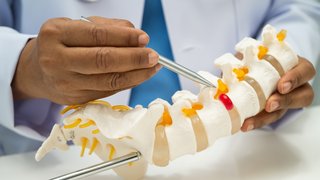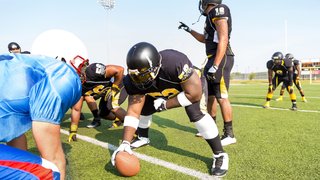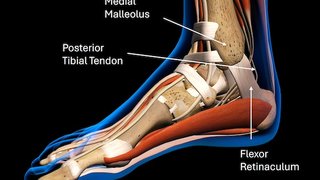Achilles tendon injuries: Why do they take so long to heal?
April 15, 2025

A torn or ruptured Achilles tendon is every athlete’s – and sports fan's – greatest fear. They always seem to happen in a split second: One quick pivot or a hard hit and, just like that, you or your favorite player are sidelined for nearly a year.
Dallas Mavericks center Dwight Powell and his fans are all-too-familiar with the pain and long rehab process related to an Achilles tear. He suffered the season-ending injury in January 2020.
And that sad saga played out again on Monday, Sept. 11, 2023, in front a national TV audience, when New York Jets quarterback Aaron Rodgers was sacked on the fourth play of his first regular season game with the team, and then sank back to turf. A day later it was confirmed: Rodgers, the 39-year-old four-time NFL MVP, tore his Achilles and would be out for the season.
Professional or weekend warrior, Achilles injuries don't discriminate. And they can often require a year or longer to fully recover, including rehab. Many pro athletes can focus solely on rebounding from their injury, but for mere mortals like you and I, it can be challenging to balance daily duties with the appointments and therapy needed so we can walk, run, and jump again.
Let’s talk about why Achilles tendon injuries take so long to heal, who might be at increased risk, and tips to prevent tears and ruptures.
First, what do the Achilles tendons do?

The Achilles tendons, which get their name from the mythological Greek hero whose lone weakness was in his heel, are the largest and strongest tendons in the body. On average, they are approximately 6 inches long and 5 millimeters thick. The Achilles is extremely important in walking, running, and jumping. Connecting the heel bones to the calf muscles at the back of the ankle, the Achilles tendons are strong enough to withstand the force of up to 1,100 pounds.
What are Achilles tendons made of?
Achilles tendons are made up of strong fibrous tissue, but this tissue does not have the greatest blood supply and that is why they are predisposed to injury and rupture.
But overstretching or straining can result in a torn tendon. Achilles tendon tears are typically classified as follows:
- Partial tear, in which some of the tendon fibers remain connected
- Compete tear, in which the tendon ruptures and all the fibers disconnect from each other
Why does Achilles tendon recovery take so long?
Unlike muscle tissue, tendons don’t get a significant supply of blood. Blood delivers fluid and nutrients that are essential for healing.
The less blood delivered, the longer it takes for tissue to heal. Add to that the sheer size of the Achilles tendon, and you’re in for a lengthy recovery. Even for professional athletes these are usually season-ending injuries, and in some cases career-ending injuries.
With a tear or rupture, you'll likely be out of commission for at least one season of your sport of choice. Even walking will be difficult, if it's possible at all, for several weeks during initial recovery.
Your treatment plan will depend on many factors, including the severity of the injury. The non-surgical approach involves keeping the foot and ankle flexed downward with a boot or cast, followed by physical therapy. The goal would be for the tear to heal itself. However, many cases require surgery for proper healing.
What happens in Achilles tendon repair surgery?
Surgical repair is usually an outpatient procedure followed by several weeks of protection in a cast or boot. Physical therapy and exercises may begin as soon as the surgical incision is healed.
You will be placed under anesthesia to sleep through the surgery. The surgeon will open the skin of the calf and back of the ankle. In some cases, minimally invasive or percutaneous repair through small incisions can be used. In other cases, an incision of about three to four inches may be necessary.
During the procedure, the surgeon will open the sheath of tissue around the tendon and remove damaged tissue. Then, they will repair the tear. If the tear is significant, the surgeon might remove a small piece of tendon from elsewhere in your foot and use it to replace a portion of the Achilles tendon. Then, the surgeon will close the incision with sutures. Most patients can return home the same day.
With surgical or nonsurgical treatment, you likely will be walking normally in about three months. Physical therapy will focus on regaining strength in the leg and tendon, as well as increasing flexibility so you can safely perform more explosive athletic maneuvers such as running, jumping, or pivoting.
Who may be at risk for Achilles tendon injuries?
While there is a bit of randomness and bad luck when it comes to Achilles tendon tears, they are most common in healthy, active men who are 20 to 39 years old.
However, we are also treating more older people with Achilles tears than we did in the past, likely because people are staying healthy and active longer.
The incidence rate of Achilles tendon ruptures in the general public is 1.8 people per 100,000 annually. But in athletic populations, it’s between 6,000 and 18,000. Sports most commonly associated with Achilles tendon rupture are basketball, soccer, football, tennis, and running.
If you begin to experience pain in your Achilles tendon, stop whatever activity you are doing and rest. Minor injuries may not require medical treatment. If the pain persists, see a doctor. However, if you hear a popping or snapping sound at the time of the injury, see your doctor right away. This indicates you may have completely torn the tendon.
How can you prevent Achilles tendon injuries?
They may be strong and durable, but it’s still important to take care of your Achilles tendons. The best thing you can do for them is to ease into activities and gradually train them to do what you want them to do.
You can reduce your risk of Achilles injuries by:
- Warming up and cooling down every time you exercise or play sports
- Slowly increasing the length and intensity of workouts
- Avoiding or limiting exercise on uneven surfaces
- Wearing well-fitting shoes
If you tear your Achilles tendon, you can expect a long recovery. But our team of foot and ankle specialists, orthopaedic surgeons, and physical therapists will work with you to get on your feet and back in the game as soon as possible.
To talk to one of our experts about an Achilles tendon injury, call 214-645-8300 or schedule an appointment online.











